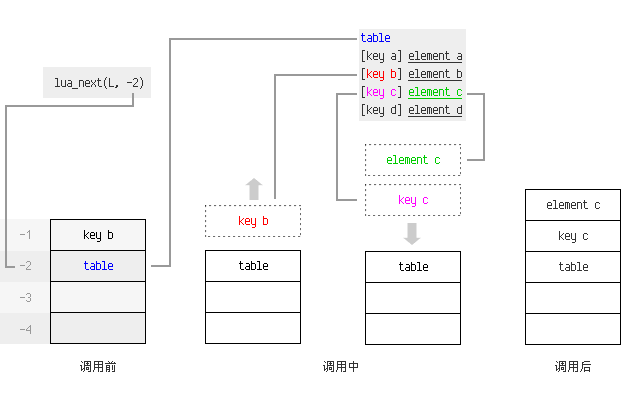Lua 学习笔记:C API 遍历 Table
分类:技术
前情提要
Lua 通过一个虚拟栈与 C 的交互,正数索引自底向上取值,负数索引自顶向下取值。
Lua 中的 Table(表)结构可以使用任何数据作为 key 进行取值。使用 C API 访问 Table 中的元素有两种方法:
lua_getglobal(L, t);
lua_pushinteger(L, k); -- 这里可以换成其它类型的 lua_pushXXXX(L, k) 压数据到栈顶作key
lua_gettable(L, -2);
lua_getglobal(L, t);
lua_getfield(L, -1, k);
在结束时,栈上的情况均为:栈顶为 t[k],次顶元素为 Table 类型的 t。第二种方法其实是第一种方法在「key 为字符串」时的特殊写法。
C API 遍历 Table
lua_getglobal(L, t);
lua_pushnil(L);
while (lua_next(L, -2)) {
/* 此时栈上 -1 处为 value, -2 处为 key */
lua_pop(L, 1);
}
lua_next 函数针对 -2 处(参数指定)的 Table 进行遍历。弹出 -1 处(栈顶)的值作为上一个 key(为 nil 时视为请求首个 key),压入 Table 中的下一个 key 和 value。返回值表示是否存在下一个 key。

另外在循环中处理值时要记得随时清理栈,否则 Table 就不在 -2 了。(也可以考虑在 lua_getglobal 后用 lua_gettop 存下 Table 的正数索引。)
虽然这是手册中记载的遍历方法,但这种方法在遍历时并没有一定的遍历顺序,于是便又有了下面的方法。
用整数 Key 进行并不那么完美的遍历
lua_getglobal(L, t);
len = lua_objlen(L, -1);
for (i = 1; i <= len; i++) {
lua_pushinteger(L, i);
lua_gettable(L, -2);
/* 此时栈顶即为 t[i] 元素 */
lua_pop(L, 1);
}
这种方法无视了非整数 key,但可以保证遍历顺序。如果只关注整数 key,可以考虑用这种遍历方法 :)